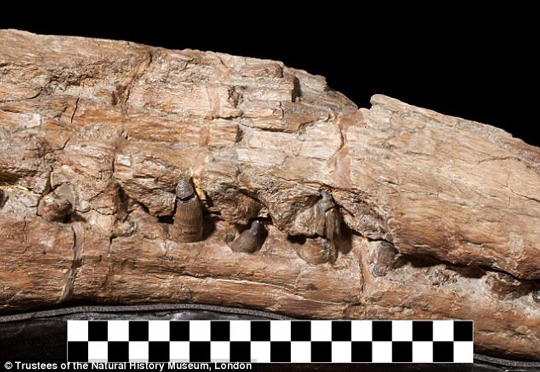Lemmysuchus obtusidens – Named after Lemmy from Motorhead
On December 28th 2015, the English heavy-metal musician, Lemmy, the founder of Motörhead and doyen of the metal-music genre passed away. Since that day, many scientists who were fans of Lemmy’s music have sought out ways to honour him*. It seems that tracks such as “Bomber”, “Overkill”, “Louie Louie” and the iconic “Ace of Spades” are very popular with academics and scientists from a number of disciplines and this week, hard-drinking, hard-living Lemmy, was honoured by having a particularly nasty Jurassic teleosaurid crocodile named after him. Say hello to Lemmysuchus obtusidens, the newest member of the Teleosauridae, the name means “Lemmy’s blunt-toothed crocodile”.
Lemmysuchus obtusidens
Dorsal View of the Skull of Lemmysuchus obtusidens
Picture credit: Trustees of the Natural History Museum, London
From a Clay Pit Near Peterborough
The fossil material now assigned to this new genus was excavated in 1909 from a clay pit near the town of Peterborough (Cambridgeshire), several specimens were collected from the Middle Jurassic strata (Callovian faunal stage). It was incorrectly catalogued and assigned to a different species, several cladistic and anatomical reviews later and the blunt-snouted, blunt-toothed teleosaurids have undergone a significant revision and fossil material formerly assigned to Steneosaurus obtusidens has ended up in need of a new taxa hence the establishment of Lemmysuchus within the academic literature.
One of the authors of the scientific paper, which has just been published in the Zoological Journal of the Linnean Society, Michela Johnson (University of Edinburgh), described Lemmysuchus:
“With a metre-long skull and a total length of 5.8 metres, it would have been one of the biggest coastal predators of its time.”
A Close View of the Jaw Showing the Robust Teeth
Picture credit: Trustees of the Natural History Museum, London
Lemmysuchus – Durophagous or Macrophagous Diet
In contrast to several other Middle Jurassic teleosaurids, Lemmysuchus had a broad snout and large, robust teeth, this suggests that this substantial crocodylomorph had a different diet to its relatives. Most teleosaurids were fish-eaters and their jaws, teeth and skulls show adaptations to a piscivorous diet. The jaws of Lemmysuchus indicate that this reptile might have dined on turtles or other hard-shelled creatures such as ammonites.
It could have made short work of any small marine reptile carcass that it found, it could even have been an active predator of other marine reptiles.
A Nasty Crocodile from the Middle Jurassic of England
Picture credit: Mark Witton
Paleoartist Dr Mark Witton has recreated the terrifying world of Lemmysuchus obtusidens. The beautiful reconstruction shows a large Lemmysuchus feeding on a plesiosaur, whilst rhamphorhynchoid pterosaurs scavenge the remains of an ichthyosaur that has been washed ashore.
Subtle Nods to Lemmy and to John Martin
The atmospheric image created by Mark Witton, includes a subtle hint towards one of the pieces of artwork associated with Motörhead. The pattern on top of the crocodylomorph’s skull is a homage to the “snaggletooth” logo that adorned a number of album covers. In addition, this stunning artwork, depicting a European shoreline some 164 million years ago, pays tribute to one of the earliest depictions of ancient marine reptiles, an illustration by John Martin for the seminal publication “Great Sea Dragons”, by Thomas Hawkins, which was first printed back in 1840.
John Martin depicted a savage, violent seascape dominated by great serpent-like creatures. Having noted the serpentine archway in Dr Witton’s illustration, Everything Dinosaur contacted Mark and enquired how this archway came to be included.
Mark explained:
“The archway in the background is a nod to the serpentine creature in the background of John Martin’s classic 1840 illustration “The Sea-Dragons as They Lived”. Much of the right side of the image is a tribute to this work, as is the fact that virtually all the animals in my painting are savage and predatory. We know that the Jurassic didn’t have any serpentine creatures like those imagined by Martin, so I had to improvise a little by changing his animal to a rock feature and landmass (the adjacent island is where the second ‘hump’ of his creature would be).”
Mark added:
“I decided to homage his work because, in a lot of ways, 19th century palaeoart is not dissimilar to iconography associated with the harder side of rock music, to which Lemmysuchus has an obvious connection. Both are a bit silly in how dark and aggressive they are so, though stemming from very different cultures, they’re actually artistic bedfellows.”
“Great Sea Dragons” Illustration by John Martin circa 1840
Talented paleoartist Mark has recently published a new work, highlighting his illustrations and providing an insight into the process or imagining and then recreating prehistoric scenes. The book is entitled “Recreating an Age of Reptiles”, it is highly recommended.
To read a review of “Recreating an Age of Reptiles”: A Review of “Recreating the Age of Reptiles”.
Dr Witton added:
“It was quite fun bringing three very different influences together for this painting: the science of the animal itself; the aggressive, dark imagery associated with Motörhead and the influence of old school palaeoart.”
Lemmy from Motörhead (Ian Fraser Kilmister)
Co-author Lorna Steel, (Dept. of Earth Sciences, Natural History Museum), proposed that the fearsome crocodylomorph should be named after her late musical hero.
Dr Steel stated:
“Although Lemmy passed away at the end of 2015, we’d like to think that he would have raised a glass to Lemmysuchus, one of the nastiest sea creatures to have ever inhabited the Earth.”
*In early 2016, a petition was organised to get the discoverers of the recently named, super-heavy element 115 Ununpentium, to change its name to Lemmium. Despite attracting a reported 100,000 signatures the bid to place the heavy metal music pioneer onto the Periodic Table failed. Still it’s not every day that you get a bone-crushing, Jurassic marine crocodile named after you.
Visit the award-winning Everything Dinosaur website: Everything Dinosaur.










Leave A Comment